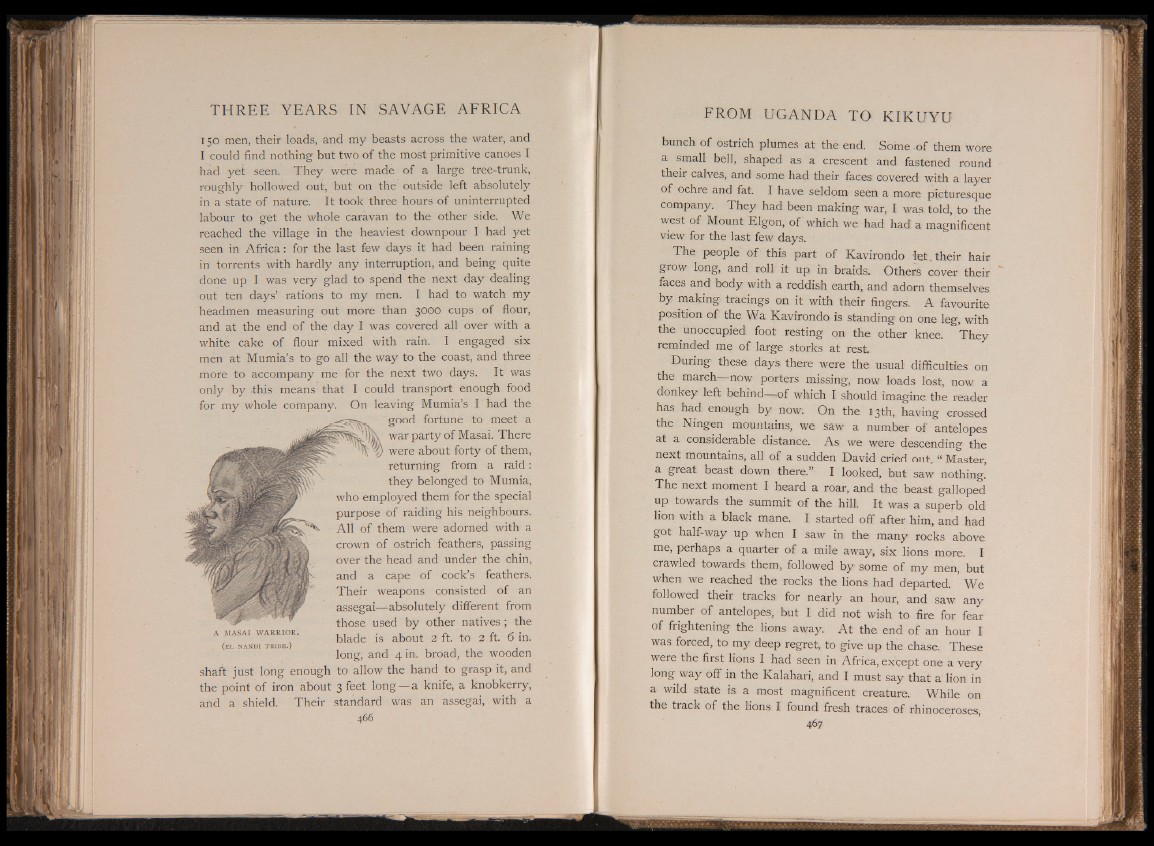
1 50 men, their loads, and my beasts across the water, and
I could find nothing but two of the most primitive canoes I
had yet seen. They were made of a large tree-trunk,
roughly hollowed out, but on the outside left absolutely
in a state of nature. It took three hours of uninterrupted
labour to get the whole caravan to the other side. We
reached the village in the heaviest downpour I had yet
seen in Africa: for the last few days it had been raining
in torrents with hardly any interruption, and being quite
done up I was very glad to spend the next day dealing
out ten days’ rations to my men. I had to watch my
headmen measuring out more than 3000 cups of flour,
and at the end of the day I was covered all over with a
white cake of flour mixed with rain. I engaged six
men at Mumia’s to go all the way to the coast, and three
more to accompany me for the next two days. It was
only by this means that I could transport enough food
for my whole company. On leaving Mumia’s I had the
good fortune to meet a
%\ war party of Masai. There
^ V were about forty of them,
returning from a raid:
they belonged to Mumia,
who employed them for the special
purpose of raiding his neighbours.
All of them were adorned with a
crown of ostrich feathers, passing
over the head and under the chin,
and a cape of cock’s feathers.
Their weapons consisted of an
assegai—absolutely different from
those used by other natives; the
blade is about 2 ft. to 2 ft. 6 in.
long, and 4 m. broad, the wooden
shaft just long enough to allow the hand to grasp it, and
the point of iron about 3 feet long—a knife, a knobkerry,
and a shield. Their standard was an assegai, with a
466
A MASAI WARRIOR.
(e l NANDI T R IB E .)
bunch of ostrich plumes at the end. Some .of them wore
a small bell, shaped as a crescent and fastened round
their calves, and some had their faces covered with a layer
of ochre and fat. I have seldom seen a more picturesque
company. They had been making war, I was told, to the
west of Mount Elgon, of which we had had; a magnificent
view for the last few days.
The people of this part of Kavirondo fet, their hair
grow long, and roll it up in braids. Others cover their
faces and body with a reddish earth, and adorn themselves
by making tracings on it with their fingers. A favourite
position of the Wa Kavirondo is standing on one leg, with
the unoccupied foot resting on the other knee. They
reminded me of large storks at rest.
During these days there were the usual difficulties on
the march—now porters missing, now loads lost, now a
donkey left behind—of which I should imagine the reader
has had enough by now. On the 13th, having crossed
the Ningen mountains, we saw a number of antelopes
at a considerable distance. As we were descending the
next mountains, all of a sudden David cried out, “ Master,
a great beast down there.” I looked, but saw nothing.
The next moment I heard a roar, and the beast galloped
up towards the summit of the hill. It was a superb old
lion with a black mane. I started off after him, and had
got half-way up when I saw in the many rocks above
me, perhaps a quarter of a mile away, six lions more. I
crawled towards them, followed by some of my men, but
when we reached the rocks the lions had departed. ’ We
followed their tracks for nearly an hour, and saw any
number of antelopes, but I did not wish to fire for fear
of frightening the lions away. At the end of an hour I
was forced, to my deep regret, to give up the chase. These
were the first lions I had seen in Africa, except one a very
long way off in the Kalahari, and I must say that a lion in
a wild state is a most magnificent creature. While on
the track of the lions I found fresh traces of rhinoceroses,
467